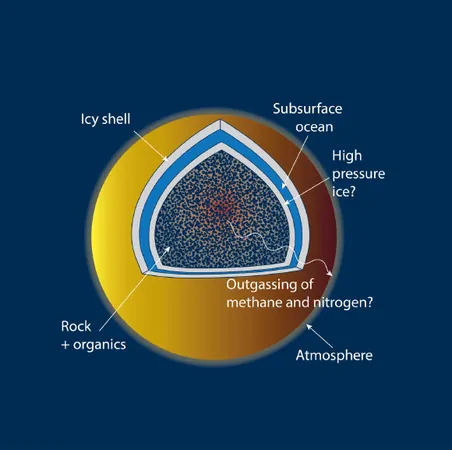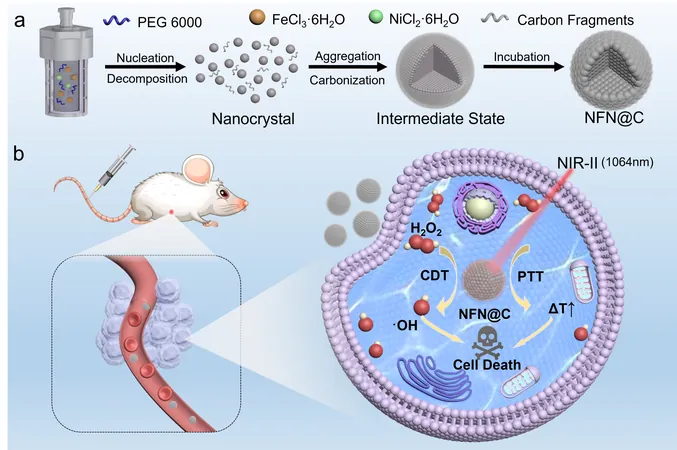
New Experiments Illuminate the Secrets Behind Titan's Nitrogen-Rich Atmosphere
2025-01-27
Author: Sarah
Key Findings
Recent groundbreaking research from the Southwest Research Institute and Carnegie Institution for Science has revealed critical insights into the processes that sustain the unique nitrogen-rich atmosphere of Saturn’s moon Titan. The study suggests that heating complex organic materials in the presence of water may play a crucial role in generating Titan's abundant atmospheric nitrogen and methane.
Titan's Atmosphere
Since its discovery in 1944, Titan has captivated the scientific community with its atmosphere, which consists of roughly 95% nitrogen and 5% methane. 'Titan, despite being only 40% the diameter of Earth, boasts an atmosphere that is 1.5 times denser,' notes Dr. Kelly Miller, a researcher at Southwest Research Institute. 'Walking on Titan's surface would feel eerily similar to scuba diving due to the atmospheric pressure.'
The Importance of Methane
Methane is especially vital for Titan's atmospheric stability. However, researchers warn that sunlight-induced reactions deplete methane, predicting that it would vanish in about 30 million years without a source to replenish it, consequently freezing the atmosphere onto the moon’s surface. The necessity for a continuous internal supply of methane has led scientists to investigate potential origins for this gas.
Research Methodology
Dr. Miller and his colleagues previously proposed a model suggesting Titan’s atmosphere may form and renew over time through the heating of complex organic materials located in Titan's rocky interior. This process releases both nitrogen and carbon gases, including methane, which then escape to the surface, creating the thick atmosphere surrounding Titan.
Experimental Results
The research team's recent experiments involved heating organic materials to temperatures between 250 and 500 degrees Celsius at pressures of up to 10 kilobars to replicate the conditions found within Titan. The results were remarkable; these experiments generated substantial quantities of methane and carbon dioxide, indicating that such processes could feasibly replenish Titan's atmospheric reservoir.
Influence of Temperature
'Our findings show that both methane and carbon dioxide are formed, with their ratios influenced by various factors, particularly temperature,' the researchers reported. Notably, the team found that if temperatures exceed 250 degrees Celsius, sufficient methane can be generated to sustain Titan’s atmosphere. Furthermore, nitrogen was also released in the form of ammonia, potentially accounting for at least 50% of Titan’s atmospheric nitrogen.
Isotopic Characteristics
The isotopic characteristics of the materials released during these reactions align with current scientific understanding of the complex organic compounds that have accreted on Titan over time and suggest a dynamic, evolving atmosphere.
Context and Implications
This research builds on the extensive data collected during NASA's Cassini-Huygens mission, which conducted its exploration of the Saturn system from 2004 to 2017, leaving scientists with invaluable insights into the intriguing moon.
The implications of this study extend beyond understanding Titan itself, as they could also provide clues about the atmospheric processes of other celestial bodies, enhancing our knowledge of planetary formation and evolution across the universe. For anyone fascinated by space exploration and the mysteries of our solar system, Titan's story is an extraordinary glimpse into the complex interactions that sustain life-sustaining atmospheres.



 Brasil (PT)
Brasil (PT)
 Canada (EN)
Canada (EN)
 Chile (ES)
Chile (ES)
 Česko (CS)
Česko (CS)
 대한민국 (KO)
대한민국 (KO)
 España (ES)
España (ES)
 France (FR)
France (FR)
 Hong Kong (EN)
Hong Kong (EN)
 Italia (IT)
Italia (IT)
 日本 (JA)
日本 (JA)
 Magyarország (HU)
Magyarország (HU)
 Norge (NO)
Norge (NO)
 Polska (PL)
Polska (PL)
 Schweiz (DE)
Schweiz (DE)
 Singapore (EN)
Singapore (EN)
 Sverige (SV)
Sverige (SV)
 Suomi (FI)
Suomi (FI)
 Türkiye (TR)
Türkiye (TR)